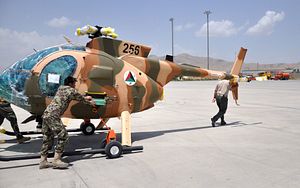Last week, the Afghan Air Force (AAF) received five new MD530F Cayuse Warrior light attack helicopters, according to a U.S. Air Force press release. The five airframes arrived at Hamid Karzai International Airport via a C-17 Globemaster III transport aircraft on June 17, in the middle of this year’s fighting season.
“These five latest (MD-530s) have the capability to fire rockets or .50-caliber machine guns and sighting systems that aren’t on the previously-delivered helicopters,” said Lieutenant Colonel Bill Ashford, 438th Air Expeditionary Advisory Squadron commander. “We are also getting kits to modify the existing 13 to be able to support guns and rockets, but these five will be the first with both capabilities in service here.”
The new sighting systems close a critical capability gap of the MD-530 gunships in service with the AAF. As I noted in a January 2016 piece for The Diplomat Magazine, I personally witnessed two MD-530s in action that lacked proper gun sights for their two .50 caliber machine guns. The two helicopters periodically appeared on the battlefield, but had obvious difficulties locating and engaging enemy fighters.
Although not mentioned in the press release, it is likely that the five MD-530s recently delivered have been fitted with the so-called Enhanced Mission Equipment Package (EMEP). In detail, according to MD Helicopters, the EMEP includes:
- Rhode & Schwarz M3AR tactical radio communications solution
- Aviatech tactical communication antennas
- DillonAero Mission Configurable Aircraft System (MCAS) and fixed-forward sighting system
- Kinetic Defense ballistic armor panels
- FN HMP400 .50 caliber gun pods from FN Herstal
- 2.75” rocket capability
A number of pilots within the AAF have openly expressed their dissatisfaction with the new MD-530. As I previously reported (See: “Afghanistan’s Newest Attack Helicopter a ‘Total Mess’?”), “It’s unsafe to fly, the engine is too weak, the tail rotor is defective and it’s not armored. If we go down after the enemy we’re going to have enemy return fire, which we can’t survive. If we go up higher, we can’t visually target the enemy,” one of Afghanistan’s most decorated pilots, Colonel Qalandar Shah Qalandari, noted. “Even the guns are no good.”
“Some Afghans were skeptical of the MD-530 when it first started operating, however, it has proven itself in combat,” said Ashford. “Now everyone wants MD-530 support. The pilots are doing great work flying daily combat missions supporting (ANA) troops on the ground and escorting AAF Mi-17s in the air.”
At least some of the shortcomings listed above appear to have been addressed now, although the larger question is whether the AAF is deploying the MD-530 for the right types of missions.
“We’ve seen a steady increase in the employment of the (MD-530),” said one U.S. Air Force officer in Kabul. “Adding these five new helicopters will give the AAF the ability to fly even more critical missions.” The AAF is slated to receive nine more MD-530s by the end of August, bringing total MD-530 strength up to 27.

































